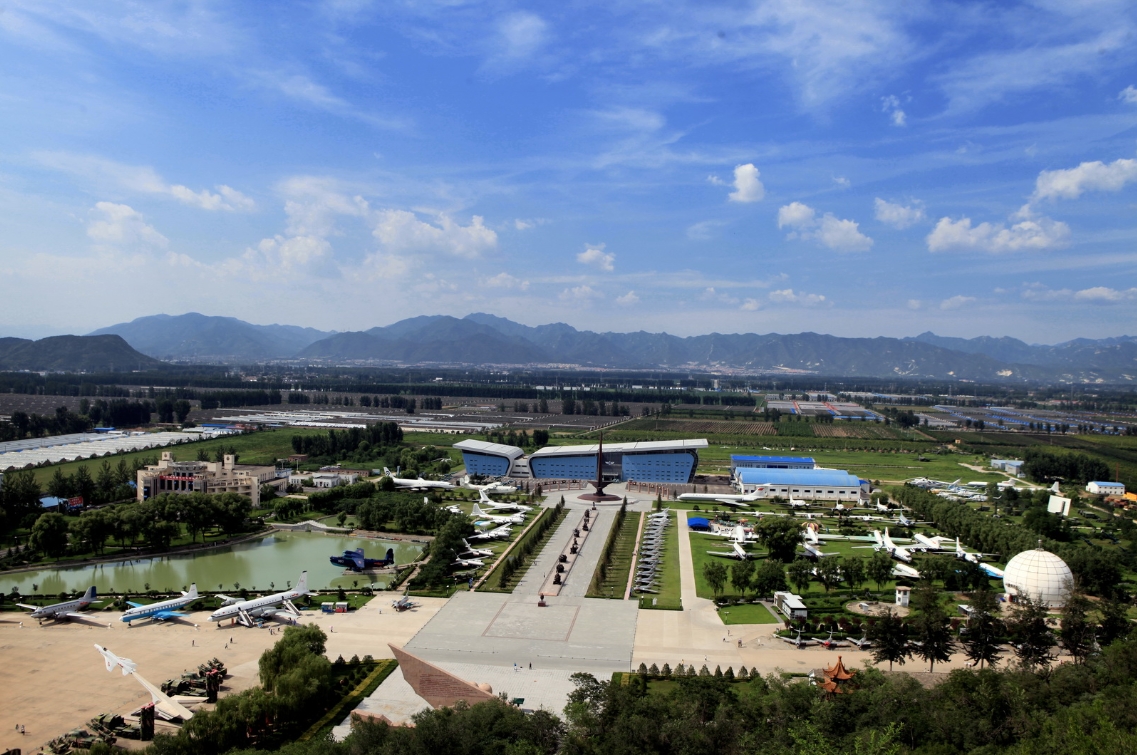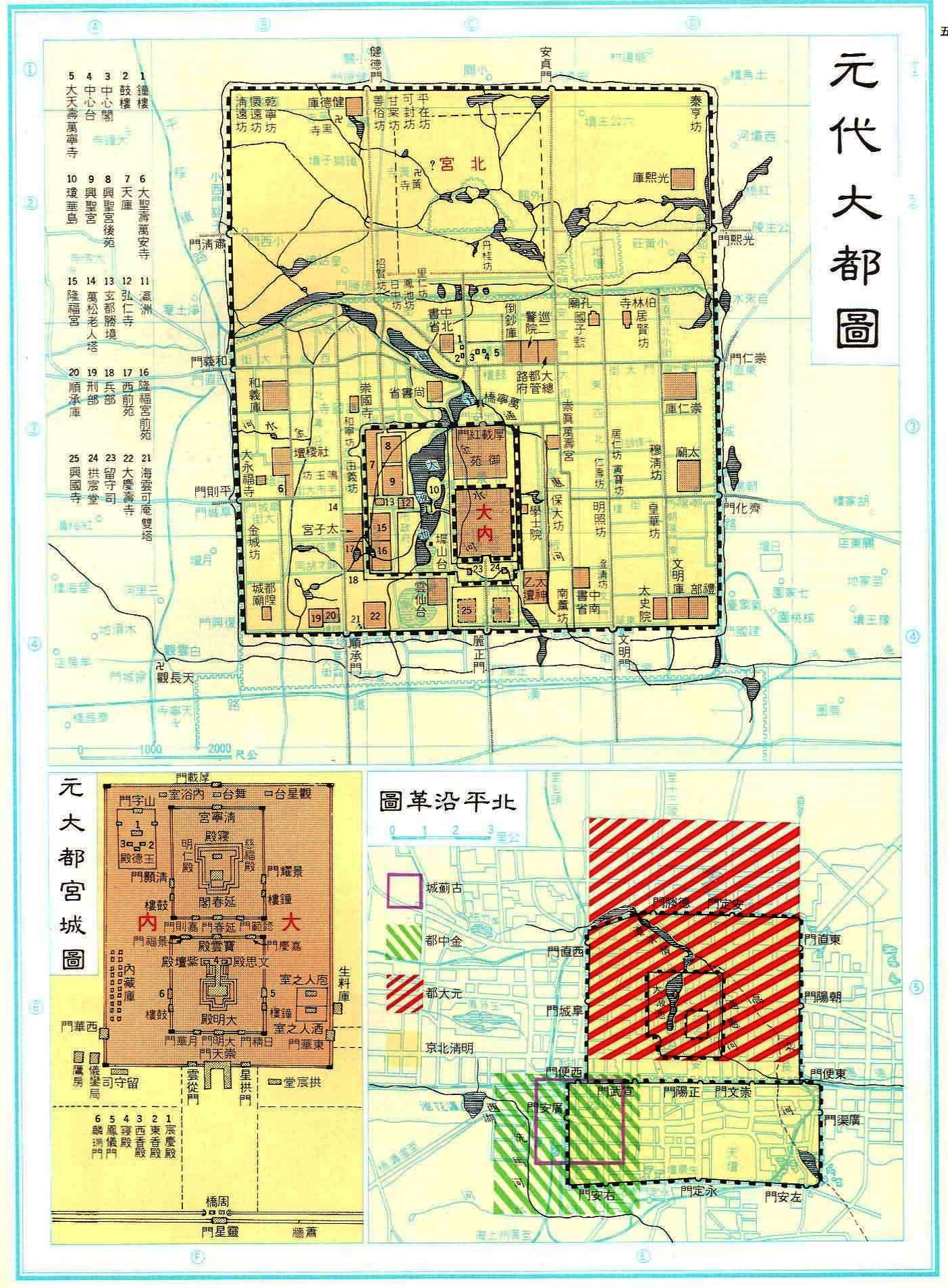
 Beijing Shi-BJ
Beijing Shi-BJ
 China
China
 Chinese Super League 2019
Chinese Super League 2019

 Financial
***Global Financial Center
Financial
***Global Financial Center

 History
N 2000 - 2100 AD
History
N 2000 - 2100 AD

 History
L 1000 - 1500 AD
History
L 1000 - 1500 AD

 History
M 1500 - 2000 AD
History
M 1500 - 2000 AD

 International cities
***Global Urban Economic Competitiveness
International cities
***Global Urban Economic Competitiveness
 ITU World Championship Series
ITU World Championship Series
 Beijing-Hangzhou Grand Canal
Beijing-Hangzhou Grand Canal
 League of Legends
League of Legends World Championship
League of Legends
League of Legends World Championship
 Olympic Summer Games
Olympic Summer Games
 2022 Winter Olympics
2022 Winter Olympics
 Silk road
Silk road
 Shanghai Cooperation Organization
Shanghai Cooperation Organization

 Sport
Triathlon
Sport
Triathlon

 World Heritage
World Heritage
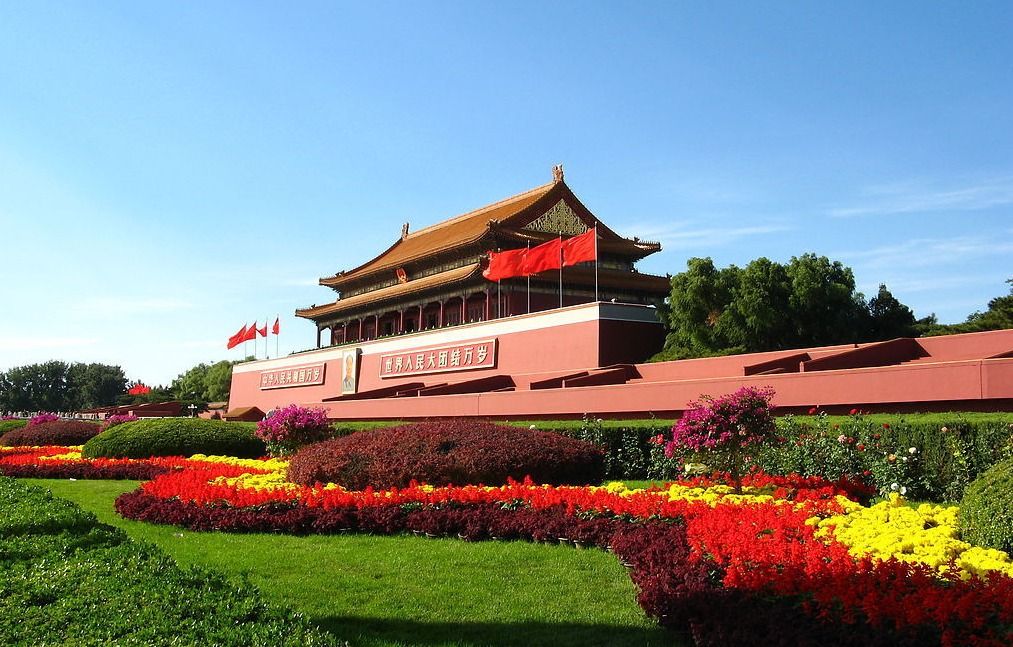
北京,简称“京”,是中华人民共和国的首都、直辖市、国家中心城市、超大城市、国际大都市,全国政治中心、文化中心、国际交往中心、科技创新中心,是中国共产党中央委员会、中华人民共和国中央人民政府、全国人民代表大会、中国人民政治协商会议全国委员会、中华人民共和国中央军事委员会所在地,也是中部战区司令部驻地。
北京位于华北平原北部,背靠燕山,毗邻天津市和河北省。北京的气候为典型的北温带半湿润大陆性季风气候。
北京是首批国家历史文化名城和世界上拥有世界文化遗产数最多的城市,三千多年的历史孕育了故宫、天坛、八达岭长城、颐和园等众多名胜古迹。早在七十万年前,北京周口店地区就出现了原始人群部落“北京人”。公元前1045年,北京成为蓟、燕等诸侯国的都城。公元938年以来,北京先后成为辽陪都、金中都、元大都、明、清国都。1949年10月1日成为中华人民共和国首都。
北京被全球权威机构GaWC评为世界一线城市 。联合国报告指出,北京人类发展指数居中国城市第二位 。2017年,北京人均可支配收入达到57230元,社会消费品零售总额11575.4亿元 。北京住户存款总额和人均住户存款均居全国第一 。2017年,北京高新技术企业达到20183家。 福布斯2017年“中国大陆最佳商业城市排行榜”排第3位。
2015年7月31日,国际奥委会主席巴赫宣布北京携手张家口获得2022年冬季奥林匹克运动会的举办权。北京由此成为全球首个既举办过夏季奥运会又将举办冬季奥运会的城市。
北京是一座有着三千多年历史的古都,在不同的朝代有着不同的称谓,大致算起来有二十多个别称。
燕都,据史书记载,公元前1122年,周武王灭商以后,在燕封召公。燕都因古时为燕国都城而得名。战国七雄中有燕国,据说是因临近燕山而得国名,其国都称为“燕都”。
幽州,远古时代的九州之一。幽州之名,最早见于《尚书·舜典》:“燕曰幽州。”两汉、魏、晋、唐代都曾设置过幽州,所治均在今天的北京一带。
京城,京城泛指国都,北京成为国都后,也多将其称为京城。
南京,辽太宗会同元年(938年),将原来的幽州升为幽都府,建号南京,又称燕京,作为辽的陪都。当时辽的首都在上京。
大都,元代以金的离宫今北海公园为中心重建新城,元世祖至元九年(1272年)改称大都,俗称元大都。
北平,明代洪武元年(1368年),朱元璋灭掉元朝后,为了记载平定北方的功绩,将元大都改称北平。
北京,明永乐元年(1403年),明成祖朱棣永乐皇帝取得皇位后,将他做燕王时的封地北平府改为顺天府,建北京城,并准备迁都城于此,这是正式命名为北京的开始,至今已有600余年的历史。
京师,明成祖于永乐十八年(1420年)迁都北京,改称京师,直至清代。
京兆,民国二年(1913年)废顺天府,翌年置京兆地方,直隶中央,其范围包括今天的北京大部分地区,民国十七年(1928年)废京兆地方,改北京为北平。
Peking (chinesisch 北京, Pinyin Běijīng, W.-G. Pei-ching auch Beijing,  [pei˨˩tɕiŋ˥˥], deutsch historisch Pekingen[2]) ist die Hauptstadt der Volksrepublik China. Der Name bedeutet Nördliche Hauptstadt (vgl. Nanjing für Südliche Hauptstadt). Peking hat eine über dreitausendjährige Geschichte und ist heute eine regierungsunmittelbare Stadt, das heißt, sie ist direkt der Zentralregierung unterstellt und damit Provinzen, autonomen Gebieten und Sonderverwaltungszonen gleichgestellt.
[pei˨˩tɕiŋ˥˥], deutsch historisch Pekingen[2]) ist die Hauptstadt der Volksrepublik China. Der Name bedeutet Nördliche Hauptstadt (vgl. Nanjing für Südliche Hauptstadt). Peking hat eine über dreitausendjährige Geschichte und ist heute eine regierungsunmittelbare Stadt, das heißt, sie ist direkt der Zentralregierung unterstellt und damit Provinzen, autonomen Gebieten und Sonderverwaltungszonen gleichgestellt.
Das gesamte 16.807 Quadratkilometer große (etwas größer als Schleswig-Holstein) Verwaltungsgebiet Pekings hat 21,5 Millionen Einwohner (Stand: März 2016).[3] Es stellt kein zusammenhängendes Stadtgebiet dar, mit seiner dominierenden ländlichen Siedlungsstruktur ist es eher mit einer Provinz vergleichbar.[4] Von der Gesamtbevölkerung sind 11,8 Millionen registrierte Bewohner mit ständigem Wohnsitz (戶口 / 户口, hùkǒu) und 7,7 Millionen temporäre Einwohner (流動人口 / 流动人口, liúdòng rénkǒu) mit befristeter Aufenthaltsgenehmigung (暫住證 / 暂住证, zànzhùzhèng).[5] Wird die Kernstadt (hohe Bebauungsdichte und geschlossene Ortsform) als Grundlage genommen, leben in Peking 7,7 Millionen Menschen mit Hauptwohnsitz (2007).[6] Der Ballungsraum (einschließlich Vororte) hat 11,8 Millionen Einwohner (2007).[7] Ab 2017 soll die Metropole Kern einer Megalopolis von 130 Millionen Einwohnern namens Jing-Jin-Ji werden.
Peking stellt als Hauptstadt das politische Zentrum Chinas dar. Aufgrund der langen Geschichte beherbergt Peking ein bedeutendes Kulturerbe. Dies umfasst die traditionellen Wohnviertel mit Hutongs, den Tian’anmen-Platz (chinesisch Platz am Tor des Himmlischen Friedens), die 1987 von der UNESCO zum Weltkulturerbe erklärte Verbotene Stadt, den neuen und alten Sommerpalast und verschiedene Tempel, wie z. B. den Himmelstempel, den Lamatempel und den Konfuziustempel.(2012)
北京市(ペキンし、中国語: 北京市、拼音: Běijīng)は、中華人民共和国の首都である。
行政区画上は直轄市であり、中国の華北の中央に位置する。人口は2152万(2014年)であり、中国では上海に次ぐ第二の都市。世界有数のメガシティであり、極めて高い影響力を有する世界都市でもある。古くは大都・燕京・北平とも呼ばれた。
春秋戦国時代には燕の首都で薊(けい)と称された。周の国都洛陽からは遠く離れ、常に北方の匈奴などの遊牧民族の侵入による被害を受ける辺境であった。秦漢代には北平(ほくへい)と称されるが、満州開発が進み、高句麗など周辺国の勢力が強大となると、戦略上、また交易上の重要な拠点として重視されるようになった。北京市に隣接する河北省涿郡(たくぐん)は三国志の英雄劉備の故郷で知られるとともに隋の煬帝が築いた大運河の北の起点とされている。
唐末五代の騒乱期、内モンゴルから南下してきた遼朝は、後晋に対し軍事支援を行った代償として北京地方を含む燕雲十六州を割譲された。遼はこの都市を副都の一つ南京と定めた。その後金朝が遼を滅ぼし支配権を獲得すると、金は北京に都城を定め中都とした。更にモンゴル帝国(元朝)が金を滅ぼすと大都として元朝の都城となり、カラコルムに代わってモンゴル帝国の中心となった。
朱元璋が元を北方に駆逐し明朝が成立すると、名称は北平に戻され、都城は南京に定められた。しかし、燕王に封じられ北京を拠点とした朱棣(後の永楽帝)は、1402年に建文帝に対し軍事攻撃を行い政権を奪取。皇帝に即位した後北京遷都を実行し地名を北京に改めた。辛亥革命後は中華民国北洋政府は北京を首都と定めたが、南京を首都と定めた蒋介石を中心とする国民政府は、「政府直轄地域」を意味する直隷省を1928年6月15日に河北省へ、北の首都を意味する北京を北平(ほくへい、ベイピンBěipíng)へと、それぞれ改称した。1937年から1945年まで続いた日本軍占領期は北京の名称が用いられ(公式には1940年に改名)、日本の敗戦によって再び北平に改称された。
1949年10月1日の中華人民共和国成立により新中国の首都とされた北京(北平)は再び北京と改称され現在に至っている。しかし、中華人民共和国の存在を承認せず、南京を公式な首都として大陸地区への統治権を主張する中華民国(台湾)では、現在でも公式名称として「北平」の名称が用いられている。
Beijing (/beɪˈdʒɪŋ/;[10] Mandarin: [pèi.tɕíŋ] ( listen)), formerly romanized as Peking,[11] is the capital of the People's Republic of China, the world's third most populous city proper, and most populous capital city. The city, located in northern China, is governed as a municipality under the direct administration of central government with 16 urban, suburban, and rural districts.[12] Beijing Municipality is surrounded by Hebei Province with the exception of neighboring Tianjin Municipality to the southeast; together the three divisions form the Jingjinji metropolitan region and the national capital region of China.[13]
listen)), formerly romanized as Peking,[11] is the capital of the People's Republic of China, the world's third most populous city proper, and most populous capital city. The city, located in northern China, is governed as a municipality under the direct administration of central government with 16 urban, suburban, and rural districts.[12] Beijing Municipality is surrounded by Hebei Province with the exception of neighboring Tianjin Municipality to the southeast; together the three divisions form the Jingjinji metropolitan region and the national capital region of China.[13]
Beijing is an important capital and global power city, and one of the world's leading centers for politics, economy and business, finance, education, culture, innovation and technology, architecture, language, and diplomacy. A megacity, Beijing is the second largest Chinese city by urban population after Shanghai and is the nation's political, cultural, and educational center.[14] It is home to the headquarters of most of China's largest state-owned companies and houses the largest number of Fortune Global 500 companies in the world.[15] It is also a major hub for the national highway, expressway, railway, and high-speed rail networks. The Beijing Capital International Airport has been the second busiest in the world by passenger traffic since 2010,[16] and, as of 2016, the city's subway network is the busiest and second longest in the world.
Combining both modern and traditional architecture, Beijing is one of the oldest cities in the world, with a rich history dating back three millennia. As the last of the Four Great Ancient Capitals of China, Beijing has been the political center of the country for most of the past eight centuries,[17] and was the largest city in the world by population for much of the second millennium A.D.[18] Encyclopædia Britannica notes that "few cities in the world have served for so long as the political headquarters and cultural center of an area as immense as China."[19] With mountains surrounding the inland city on three sides, in addition to the old inner and outer city walls, Beijing was strategically poised and developed to be the residence of the emperor and thus was the perfect location for the imperial capital. The city is renowned for its opulent palaces, temples, parks, gardens, tombs, walls and gates.[20] It has seven UNESCO World Heritage Sites – the Forbidden City, Temple of Heaven, Summer Palace, Ming Tombs, Zhoukoudian, and parts of the Great Wall and the Grand Canal – all popular locations for tourism.[21] Siheyuans, the city's traditional housing style, and hutongs, the narrow alleys between siheyuans, are major tourist attractions and are common in urban Beijing.
Pékin2 (en chinois : 北京 ; pinyin : běijīng ; API : [pe˨˩˦i.tɕi˥ŋ] Écouter la prononciation en mandarin, littéralement « capitale du nord »), également appelée Beijing, est la capitale de la République populaire de Chine. Située dans le nord du pays, la municipalité de Pékin (北京市, abrégé en 北京), d'une superficie de 16 800 km2, borde la province du Hebei ainsi que la municipalité de Tianjin. Pékin est considérée comme le centre politique et culturel de la Chine, tandis que Hong Kong et Shanghai dominent au niveau économique.
D'abord ville périphérique de l'empire chinois sous les Han et les Tang, elle prend de l'importance lorsque les Jurchen, qui fondent la dynastie Jin, la choisissent comme leur capitale principale en 1153. Le prince mongol Kubilai Khan en fait de même sous le nom de Dadu (« grande métropole »), enfin les Ming y transfèrent leur administration en 1421, parachevant le choix de Pékin comme capitale de la Chine. Située à proximité de la Grande Muraille, Pékin abrite des monuments célèbres comme la Cité interdite et le Temple du ciel, qui sont inscrits au patrimoine mondial. De nombreuses réalisations architecturales et structurelles ont modifié la ville à l'occasion des Jeux olympiques d'été dont elle a été l'hôte en 2008. Beijing a été choisie par le CIO pour organiser les Jeux olympiques d'hiver de 2022 et sera la première ville à avoir accueilli les deux éditions de l'évènement sportif international.
Avec 21,15 millions d'habitants en 2013, Pékin est la deuxième ville la plus peuplée de Chine après Shanghai. La zone urbaine compte quant à elle 18 millions d'habitants. Le parler pékinois forme la base du mandarin standard. D'un point de vue économique, Pékin est la troisième ville de Chine par le PIB total derrière Shanghai et Hong Kong. Elle connaît une croissance économique très rapide, nettement plus de 10 % par an dans les années 2000. Un nouveau Central business district (CBD) est en construction.
Pechino (AFI: /peˈkino/[1]; in cinese 北京S, BěijīngP, letteralmente "capitale del nord", pronuncia in mandarino[?·info]) è la capitale della Cina e della municipalità omonima.
L'intera municipalità ha dimensioni pari a poco più della metà del Belgio avendone però quasi il doppio degli abitanti (21.516.000[senza fonte]). Pechino è la seconda città più popolata della Cina dopo Shanghai, la capitale di Stato più popolata al mondo, e la seconda città del mondo per popolazione. Confina esclusivamente con la provincia dell'Hebei e a sud-est con la municipalità di Tientsin.
Pekín, Pequín o Beijing (chino simplificado y tradicional: 北京, pinyin: Běijīng, Wade-Giles: Pei-ching, pronunciado: [pèi.tɕíŋ](![]() escuchar), literalmente «capital del Norte») es uno de los cuatro municipios que, junto con las veintidós provincias, cinco regiones autónomas y dos regiones administrativas especiales, conforman la República Popular China. Además Pekín es la capital del país y una de las ciudades más pobladas del mundo con 21 150 000 personas en 2013.2
escuchar), literalmente «capital del Norte») es uno de los cuatro municipios que, junto con las veintidós provincias, cinco regiones autónomas y dos regiones administrativas especiales, conforman la República Popular China. Además Pekín es la capital del país y una de las ciudades más pobladas del mundo con 21 150 000 personas en 2013.2
Situada en la periferia de la antigua civilización china, Pekín se convirtió en el baluarte de las potencias extranjeras que ocuparon China del Norte entre los siglos X y XII. La dinastía Liao estableció aquí su capital meridional, la más acreditada de las cinco del reino. La dinastía Jin, la siguiente dinastía "bárbara" emprendió un amplio proyecto urbanístico a imagen de la capital de los Song septentrionales, Kaifeng. En 1215 los mongoles arrasaron la ciudad, pero 50 años después Kublai Kan decidió edificar en ella la nueva capital.
En la zona centro-sur del trazado hipodámico se hallaba la colosal villa imperial que contenía el complejo de palacios imperiales. El emperador Yongle, el tercer Ming, decidió trasladar la capitalidad a Pekín. Las murallas del lado septentrional fueron trasladadas más hacia el Sur para que el complejo palaciego imperial, la llamada Ciudad Prohibida, quedase exactamente en el centro del plano. Así la estructura del nuevo Pekín representa la cima del urbanismo tradicional chino, basado en la organización introducida por los mongoles así como en la estructura de los palacios imperiales de Kaifeng y Nankín además de tomar en consideración las normas de la geomancia china (風水).
Pekín es uno de los cuatro municipios de China que poseen un estatus provincial y están bajo el control directo del gobierno central. Pekín ha sido municipalidad desde la creación de la República Popular China. Es una de las ciudades más pobladas de China, tan sólo superada por Shanghái en cuanto a población. Es considerada el corazón cultural, político y social de China.
Пеки́н (кит. 北京, пиньинь: Běijīng, палл.: Бэйцзин, буквально: «Северная столица») — столица и один из городов центрального подчинения Китайской Народной Республики. Пекин с трёх сторон окружён провинцией Хэбэй и граничит с Тяньцзинем на юго-востоке.
Это крупнейший железно- и автодорожный узел и один из основных авиаузлов страны. Кроме того, Пекин является политическим, образовательным и культурным центром КНР, в то время как главными экономическими центрами считаются Шанхай и Гонконг. Вместе с тем, в последнее время всё больше берёт на себя роль локомотива предпринимательской деятельности и основного поля для создания инновационных предприятий.
Входит в число четырёх древних столиц Китая. В 2008 году в городе прошли Летние Олимпийские игры. В 2022 году в городе пройдут Зимние Олимпийские игры.


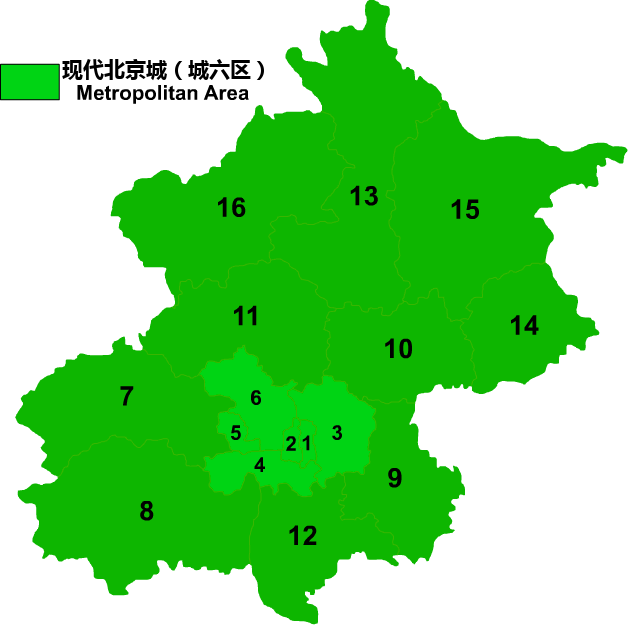
| # | 区划名称 | 汉语拼音 | 政府驻地 | 人口 (2010) | 面积 (km²) | 人口密度 (/km²) |
|---|---|---|---|---|---|---|
| | ||||||
| — 市辖区 — | ||||||
| 1 | 东城区 | Dōngchéng Qū | 景山街道 | 919,000 | 42.0 | 21881 |
| 2 | 西城区 | Xīchéng Qū | 金融街街道 | 1,243,000 | 51.0 | 24372 |
| 3 | 朝阳区 | Cháoyáng Qū | 朝外街道 | 3,545,000 | 470.8 | 7530 |
| 4 | 丰台区 | Fēngtái Qū | 丰台街道 | 2,112,000 | 304.2 | 6943 |
| 5 | 石景山区 | Shíjǐngshān Qū | 鲁谷街道 | 616,000 | 89.8 | 6860 |
| 6 | 海淀区 | Hǎidiàn Qū | 海淀街道 | 3,281,000 | 426.0 | 7702 |
| 7 | 门头沟区 | Méntóugōu Qū | 大峪街道 | 290,000 | 1331.3 | 218 |
| 8 | 房山区 | Fángshān Qū | 拱辰街道 | 814,000 | 1866.7 | 506 |
| 9 | 通州区 | Tōngzhōu Qū | 北苑街道 | 1,184,000 | 870.0 | 1361 |
| 10 | 顺义区 | Shùnyì Qū | 胜利街道 | 877,000 | 980.0 | 895 |
| 11 | 昌平区 | Chāngpíng Qū | 城北街道 | 1,661,000 | 1430.0 | 1162 |
| 12 | 大兴区 | Dàxīng Qū | 兴丰街道 | 1,365,000 | 1012.0 | 1349 |
| 13 | 怀柔区 | Huáiróu Qū | 龙山街道 | 373,000 | 2557.3 | 146 |
| 14 | 平谷区 | Pínggǔ Qū | 滨河街道 | 416,000 | 1075.0 | 387 |
| — 县 — | ||||||
| 15 | 密云县 | Mìyún Xiàn | 鼓楼街道 | 468,000 | 2335.6 | 200 |
| 16 | 延庆县 | Yánqìng Xiàn | 儒林街道 | 317,000 | 1980.0 | 160 |
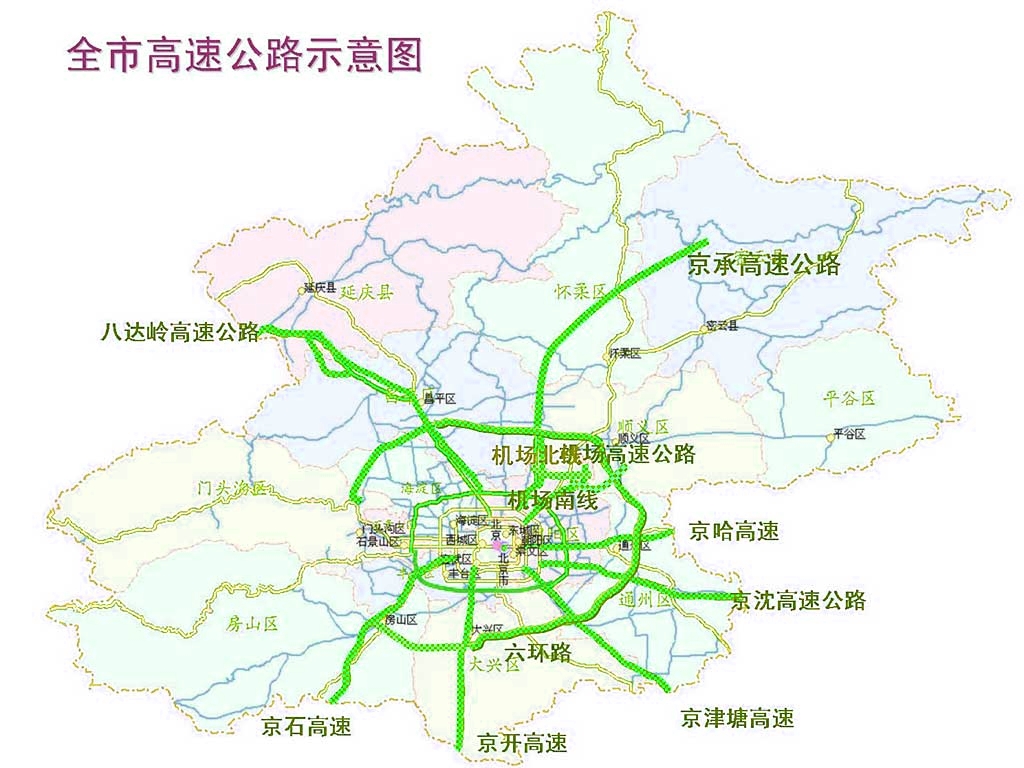
- Flughafen-Autobahn: Stadtzentrum Peking – Flughafen Peking (Richtung Nordosten)
- Jingping-Schnellstraße: Peking - Pinggu, Provinzstraße S32
- Tonyuan-Autostraße: Stadtzentrum Peking – Bezirk Tongzhou, Teil der Nationalstraße G102 (Richtung Osten)
- Jingha-Autobahn: Bezirk Tongzhou – Shenyang - Harbin, siehe Autobahn G1, früher G025 (Richtung Osten)
- Jingjin-Schnellstraße: Peking - Tianjin – Tanggu (Richtung Südosten)
- Jinghu-Autobahn: Peking - Tianjin – Shanghai, siehe Autobahn G2, früher G020 (Richtung Südosten)
- Daguang-Autobahn: Peking - Gu'an – Guangdong (Kanton), siehe Autobahn G45 und Nationalstraße G106 (Richtung Süden)
- Jinggang'ao-Autobahn: Peking – Baoding - Hongkong, siehe Autobahn G4, früher G030 (Richtung Südwesten)
- Jingkun-Autobahn: Peking – Taiyuan - Kunming, siehe Autobahn G5 (Richtung Südwesten) (im Bau)
- Jingzang-Autobahn: Stadtzentrum Peking – Badaling - Lanzhou, siehe Autobahn G6 (Richtung Nordwesten)
- Jingxin-Autobahn: Bezirk Changping – Ürümqi, siehe Autobahn G7 (Richtung Nordwesten)
- Daguang-Autobahn: Peking - Miyun – Daqing, siehe Autobahn G45 (Richtung Nordosten)
Ferner bestehen fünf Ringstraßen, die das Ringstraßennetz Peking bilden:
- 2. Ringstraße: Im Abstand von wenigen Kilometern zum Stadtzentrum, siehe 2. Ringstraße (Peking)
- 3. Ringstraße: Im Abstand von etwa 5 Kilometern zum Stadtzentrum, siehe 3. Ringstraße (Peking)
- 4. Ringstraße: Im Abstand von etwa 8 Kilometern zum Stadtzentrum, siehe 4. Ringstraße (Peking)
- 5. Ringstraße: Im Abstand von etwa 10 Kilometern zum Stadtzentrum, siehe 5. Ringstraße (Peking)
- 6. Ringstraße: Im Abstand von etwa 15-20 Kilometern zum Stadtzentrum, siehe 6. Ringstraße (Peking)
